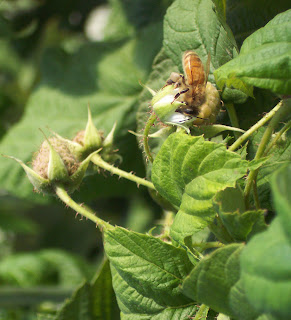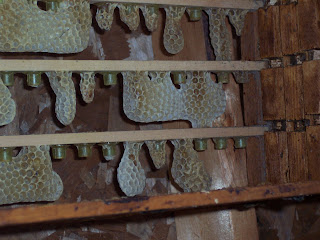Dad regularly travels out to the Lakeside/Embro, Ontario area to work on his large vegetable garden.
He had discovered a family owned Pick-Your-Own Raspberries and vegetable stand a concession over from where he was working.
Of course he didn't hesitate to set aside some time to drop in for an afternoon of berry picking.
He came home with some whopping big berries in his baskets which he was very eager to show me.
It had been a good season for the berries, enough water and sunshine.
And the last few days had been really hot and sunny.

This was why Dad came over to see me to show off his berries and to tell me his news.
It was honey bees. Lots and lots of honey bees!
Thousands of them he said, and they were all swarming happily over the raspberries.
He offered to go back the next day so we could both pick berries. Of course I wanted to go so I could photograph these bees.
But it wasn't that simple, we had to go to the farm and work in his veggie garden. So he managed to swing an afternoon of labour out of me. That was kind of clever I thought.

Then after a few hours doing that we would drop in at the raspberry place and get our berries.
The sun did not disappoint and it was another great day for bees. Not much wind and tons of sunshine.
As soon as we pulled in you could see the little dots racing back and forth over the rows of raspberries.
I got my camera out.
We took 8 quart baskets with a tape-like rope threaded through them.
We tied the rope around our waist so the basket would hang there in front, leaving our hands free for the picking.
Dad, being a complete workaholic raced to his assigned row and began picking with gusto.
Me, I wanted to enjoy the place and take my time, and visit with the bees, observe, take photos and pick some berries.
Within 5 minutes Dad had almost two pints picked. I had 5 berries in my basket (and I didn't eat any). Now I was working and not just lallygagging around. I soon figured out the problem while I watched Dad finding these super big clumps of berries where he was able to fill his pint with one clump--my row had already been picked over and so it was much more sparse. He was making me look bad!
I did my best to fill my baskets and get as many closeups as I could. We chatted with the owner when we paid our bill inside his store. I told him of my interest in bees and about the research I'd been doing for my book about bees. He showed me some tiny round holes (about 1/4") that were drilled in the edge of the facing board on his storefront porch.
The holes were drilled by Carpenter Bees. He said he could watch them coming and going and he could often see little drifts of sawdust where they had tunneled into the wood. I was glad to see that he enjoyed the study of these bees and wasn't irritated that they were drilling small holes in his wood.

The owner answered my question about where all these bees were coming from.
There were 25 beehives at the back of his property.
He said the hives belonged to a man named Bryanson, an old white-haired gentleman.
He said I was to feel free to go on back down the lane and see these hives.
So we did.
I was unprepared to visit hives that day so I did not have a veil or hat with me.

At the back of the property by the edge of the trees were about 12 hives lined up along a circular track.

I took my camera and got out of the car.
Dad waited inside the car.
Bees were everywhere.
The air was just filled with them.
There was a continual communal buzz, a happy buzz and you could tell these bees were pretty busy going about their labours collecting nectar and pollen for their stores.
I walked slowly toward the first hive and the first thing I noticed was the strong smell of honey. Wow! The last time I had been that close to hives was in very early spring on the bee course.

The bees hadn't had time yet to produce any honey.
Also, the air was cool so the honey would be chilled. But that day, standing in the bee yard, the smell of honey was very strong.
It was difficult to tell where the entrances to the hives were. I walked over to some other hives and I was trying to watch to see where the bees were coming and going from.
I noticed one hive in particular that appeared to have no activity and I wondered if the hive was dead. I was bending closer to have a look when I heard the loud buzz in my ear.
I stepped back a bit and then I felt the buzz and brush of a bee near the corner of my mouth.
What followed then was a sting. It was a slight pin prick really and nowhere near as painful as any stings I'd experienced before from hornets and yellow jackets. When the bee pulled away I felt the plop vibration--I knew that would be the back end of the bee's body being torn away with the stinger. But at the time I was moving quickly to ensure no stinger was left behind.

I heard another loud buzz by my ear and I figured that it was time to get the heck out of there.
It's sad how we say "stung by a bee". We say it from habit, but for most of us 99% of the time it was never the docile honey bee that was guilty.
Usually the stinging insect is a hornet or wasp.
There was a small amount of swelling and the pain travelled a little out from the area but it was by no means disabling.
I knew from my research that the main thing is to make sure no stinger is left behind in your skin. If the stinger was still there, then if the venom sac was still attached it would continue to pump venom. This would result in more swelling and pain. There's lots of debate whether to scrape or pull the stinger out, saying that pinching the sac would cause more venom to be pumped in. The key thing everyone agrees on is get the stinger out as quickly as possible. Often the stinger may not even remain in the flesh, which was what happened in my case.
So, I have been initiated with my first real bee sting--I'm sure it won't be my last!!!
 I confess I'm scared. I'm scared to keep bees.
I confess I'm scared. I'm scared to keep bees.  So, I'm delaying my plans. I don't even have a place to keep my hives yet. I should be calling farmers or neighbours and friends that have large lots of land to make arrangements for a place to put these hives. Instead, I'm keeping to myself.
So, I'm delaying my plans. I don't even have a place to keep my hives yet. I should be calling farmers or neighbours and friends that have large lots of land to make arrangements for a place to put these hives. Instead, I'm keeping to myself.  And I'll remind myself that I'm most definately not in this alone. There's a sea of beekeepers at the meetings each month and they are generously eager to share their wisdom.
And I'll remind myself that I'm most definately not in this alone. There's a sea of beekeepers at the meetings each month and they are generously eager to share their wisdom. 








 I heard another loud buzz by my ear and I figured that it was time to get the heck out of there.
I heard another loud buzz by my ear and I figured that it was time to get the heck out of there.








 With a little Googling around the internet and a couple emails, I was able to find out where and when the local beekeepers in my area meet.
With a little Googling around the internet and a couple emails, I was able to find out where and when the local beekeepers in my area meet.

















